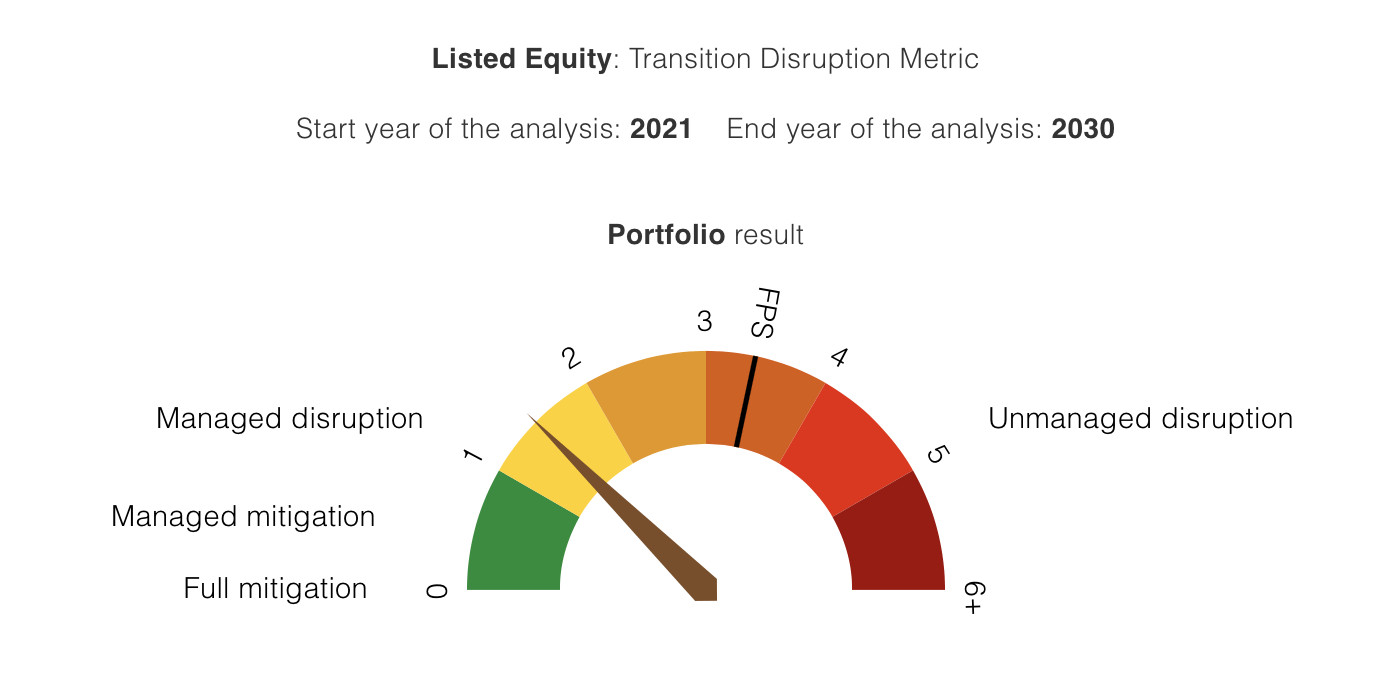- PACTA’s new Transition Disruption Metric, developed in collaboration with the Inevitable Policy Response (IPR) consortium, indicates the degree of potential future portfolio disruption stemming from a disorderly transition
- 2° Investing Initiative’s portfolio alignment tool will inform investors about possible portfolio disruption according to the IPR’s Forecast Policy Scenario out to 2030
The PACTA portfolio alignment tool now features a Transition Disruption Metric (TDM), helping investors prepare for potential portfolio disruption stemming from risks associated with a disorderly transition to a low-carbon economy. Developed by the independent, non-profit think tank 2° Investing Initiative (2DII) in collaboration with the IPR consortium, PACTA now provides the TDM alongside its flagship portfolio alignment model. It indicates the degree of potential portfolio disruption under the IPR’s new Forecast Policy Scenario (FPS), going out to 2030.
Access the TDM here.
Access the methodology document here.

The latest FPS, released just before COP26, shows that rapid policy acceleration up to and post 2025 would bring the “below 2°C” Paris Agreement goal within reach. Attaining this goal would require a significant ramp-up in energy and land use policy action, including electrifying transport, retiring coal, and ending deforestation. The new FPS is based on a high conviction forecast of likely policy developments and real economy impacts of significant acceleration in climate policy from 2025 onward, leading to a 1.8°C outcome.
In 2022, 2DII plans to integrate the new IPR core scenarios into the standard PACTA metrics as well to further facilitate investor alignment with climate goals. This will enable users to measure their alignment with the IPR scenarios set across key climate-relevant sectors and technologies.
How the Transition Disruption Metric works
The TDM measures the portfolio’s transition pace from 2021-2026 against what will be needed in the subsequent four years from 2026 in order to align with the FPS scenario by the end of 2030. In other words, it provides a quantitative score of potential disruption based on how far the portfolio lags / leads the FPS scenario in the first five years.
The indicator will be available at technology and portfolio level, subject to scenario and data availability. The higher the score, the higher the chance of portfolio disruption in the medium-term. If investors want to mitigate policy risk and transition more smoothly, they would need to move ahead of the FPS. This means they should begin adjusting exposure or engaging with companies at a faster or slower pace, according to their results under the TDM.
Maarten Vleeschhouwer, head of PACTA at 2DII, said: “Our new Transition Disruption Metric helps investors gauge how exposed they are to a disruptive transition, by comparing the pace of the transition in their portfolio for the next few years with the pace that will be required under forecast policy action post-2025. Additionally, it is among the first metrics in the market explicitly focused on helping investors address medium-term challenges. We’re proud to work with the Inevitable Policy Response on this new solution and help investors prepare for – and contribute to – the low-carbon transition.”
“Mark Fulton, Program Director at Inevitable Policy Response, said: “Incorporation of IPR scenarios in the 2DII PACTA TDM opens a new avenue for institutional investors to review their investment and portfolio risk in the face of an uneven climate transition landscape, with all its uncertainties. It represents a major step in mainstreaming IPR forecasts as the reference standard for investors looking to reduce climate based risk and achieve significant 2030 targets.”
###
About PACTA: Developed by 2° Investing Initiative, the Paris Agreement Capital Transition Assessment (PACTA) is a free, open-source methodology and tool, which measures financial portfolios’ alignment with various climate scenarios consistent with the Paris Agreement. Thus far, PACTA has been used by more than 4,500 individuals from over 3,000 institutions worldwide, as well as by supervisors and central banks to assess their regulated entities (such as the European Insurance and Occupational Pensions Authority, California Department of Insurance, Bank of England, and more).
More information here.
About our funder: This work has received funding from the European Union’s Life NGO program under Grant No LIFE20 NGO/SGA/DE/200040. This work reflects the authors’ views only, and the funders are not responsible for any use that may be made of the information it contains.

About Inevitable Policy Response (IPR): The IPR is a climate forecasting consortium that aims prepare institutional investors for the portfolio risks and opportunities associated with a forecast acceleration of policy responses to climate change. IPR contends that governments will be forced to act more decisively than they have thus far, leaving financial portfolios exposed to significant transition risk. More information is available here.
The IPR was commissioned by the Principles for Responsible Investment (PRI) in 2018 and is amongst international investor based initiatives supported by the PRI.
The IPR is led by Vivid Economics and Energy Transition Advisors (ETA). Existing research consortium partners also include 2° Investing Initiative, Carbon Tracker Initiative, Climate Bonds Initiative and Planet Tracker. Strategic Partners to IPR include BlackRock, BNP Asset Management, Fitch Ratings, Goldman Sachs Asset Management, New Forests, Nuveen and Robeco.
IPR has been funded by the Gordon and Betty Moore Foundation through The Finance Hub which was created to advance sustainable financ and the ClimateWorks Foundation. IPR receives in-kind support from the PRI.


